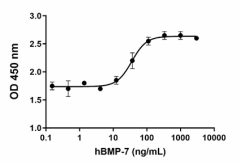- Regulatory Status
- RUO
- Other Names
- Bone Morphogenetic Protein 7, BMP7, Osteogenic Protein 1, OP-1, OP1, Eptotermin Alfa

-

Recombinant human BMP-7 induces alkaline phosphatase production in the chondrogenic cell line ATDC5. The ED50 for this effect is 18 - 72 ng/mL. -

Stability Testing for Recombinant Human BMP-7. Recombinant human BMP-7 was aliquoted in 0.1% trifluoroacetic acid (TFA) at 0.2 mg/mL and one aliquot was kept at 4°C (Control), and another was frozen and thawed four times (4x Freeze/Thaw). After this procedure, the samples were tested for their ability to induce alkaline phosphatase production in the chondrogenic cell line ATDC5. The ED50 for this effect is 18 - 72 ng/mL.
| Cat # | Size | Price | Quantity Check Availability | ||
|---|---|---|---|---|---|
| 795704 | 25 µg | $440.00 | |||
| 795706 | 100 µg | $1026.00 | |||
Bone morphogenetic proteins (BMPs) are multi-functional growth factors that belong to the transforming growth factor beta (TGFbeta) superfamily. BMPs play a key role in embryonic development, especially during heart, neural and cartilage development. Around 20 BMP family members have been identified and characterized. BMPs signal through serine/threonine kinase receptors, composed of type I and II subtypes. Four type I receptors have been identified: type IA and IB BMP receptors, type IA activin receptor, and activin receptor-like kinase I. Three type II receptors have also been recognized: type II BMP receptor and type II/IIB activin receptors. BMP-7 was initially identified as inducer of ectopic bone and cartilage. BMP-7 is a homodimeric protein; nevertheless, it is known that can form heterodimers with BMP-2 and BMP-4 with stronger activity than the homodimer, and those heterodimers are predominat functional in the early stages of embryonic mouse development. BMP-7 was recognized as an anti-fibrotic molecule, antagonizing TGF-β1. Fibrosis is associated with the emergence of fibroblasts derived from endothelial cells, suggesting an endothelial-mesenchymal transition (EndMT). TGF-β1 induces endothelial cells to undergo EndMT, whereas bone BMP-7 preserved the endothelial phenotype. BMP-7 attenuates liver fibrosis via regulation EGFR. BMP-7 inhibits fibrosis in the kidney, lung, liver, heart, peritoneum, oral submucosa tissue, and colonic wall. BMP-7 is associated to gastric cancer, lung cancer, and melanoma.
Product Details
- Source
- Human BMP-7, amino acid (Ser293 – His431) (Accession No. P18075), was expressed in CHO cells.
- Molecular Mass
- The 139 amino acid recombinant protein has a predicted molecular mass of approximately 15.68 kD. The DTT-reduced and non-reduced protein migrates at approximately 20 kD and 40 kD by SDS-PAGE, respectively. The predicted N-terminal amino acid is Ser.
- Purity
- > 95%, as determined by Coomassie stained SDS-PAGE
- Formulation
- 0.22 µm filtered protein solution is in 0.1% TFA.
- Endotoxin Level
- Less than 0.1 EU per µg cytokine as determined by the LAL method
- Concentration
- 25 µg size is bottled at 200 µg/mL. 100 µg size and larger sizes are lot-specific and bottled at the concentration indicated on the vial. To obtain lot-specific concentration and expiration, please enter the lot number in our Certificate of Analysis online tool.
- Storage & Handling
- Unopened vial can be stored between 2°C and 8°C for up to 2 weeks at -20°C for up to six months, or at -70°C or colder until the expiration date. For maximum results, quick spin vial prior to opening. The protein can be aliquoted and stored at -20°C or colder. Stock solutions can also be prepared at 50 - 100 µg/mL in appropriate sterile buffer, carrier protein such as 0.2 - 1% BSA or HSA can be added when preparing the stock solution. Aliquots can be stored between 2ᵒC and 8°C for up to one week and stored at -20°C or colder for up to 3 months. Avoid repeated freeze/thaw cycles.
- Activity
- BMP-7 induces alkaline phosphatase production in the chondrogenic cell line ATDC5. The ED50 for this effect is 18 – 72 ng/mL.
- Application
-
Bioassay
- Application Notes
-
BioLegend carrier-free recombinant proteins provided in liquid format are shipped on blue-ice. Our comparison testing data indicates that when handled and stored as recommended, the liquid format has equal or better stability and shelf-life compared to commercially available lyophilized proteins after reconstitution. Our liquid proteins are validated in-house to maintain activity after shipping on blue ice and are backed by our 100% satisfaction guarantee. If you have any concerns, contact us at tech@biolegend.com.
Antigen Details
- Structure
- Disulfide-linked homodimer
- Distribution
-
Human cancer cells, rheumatoid fibroblast-like synoviocytes
- Function
- Embryonic development and adult homeostasis
- Interaction
- Osteoblasts, Langerhans cells, adipocytes, endothelial cellsMacrophages, CD4 T cells, rheumatoid synoviocytes
- Ligand/Receptor
- Type I receptors: BMP-RIA (ALK3), BMP-RIB (ALK6), and Activin RI (ALK2) Type II receptors: BMP-RII, Act-RIIA, and Act-RIIB
- Bioactivity
- BMP-7 induces alkaline phosphatase production in the chondrogenic cell line ATDC5.
- Cell Type
- Embryonic Stem Cells, Fibroblasts, Mesenchymal Stem Cells, Osteoblasts, Osteoclasts
- Biology Area
- Cancer Biomarkers, Cell Biology, Cell Proliferation and Viability, Immuno-Oncology
- Molecular Family
- Growth Factors
- Antigen References
-
1. Chen J, et al., 2010 Anticancer Res. 30:1113
2. Aoki M, et al., 2010 Br J Cancer. 104:714.
3. Neugebauer JM, et al., 2015 Proc Natl Acad Sci U S A. 112:E2307
4. Varas A, et at., 2015 Arthritis Res Ther 17:192.
5. Reible B, et al., 2018 Int J Mol Sci. 19:1674.
6. Kim HS, et al., 2019 eLife 8: e48872.
7. Cortez MA, et al., 2020 Nat Commun. 11:4840. - Gene ID
- 655 View all products for this Gene ID
- UniProt
- View information about BMP-7 on UniProt.org
